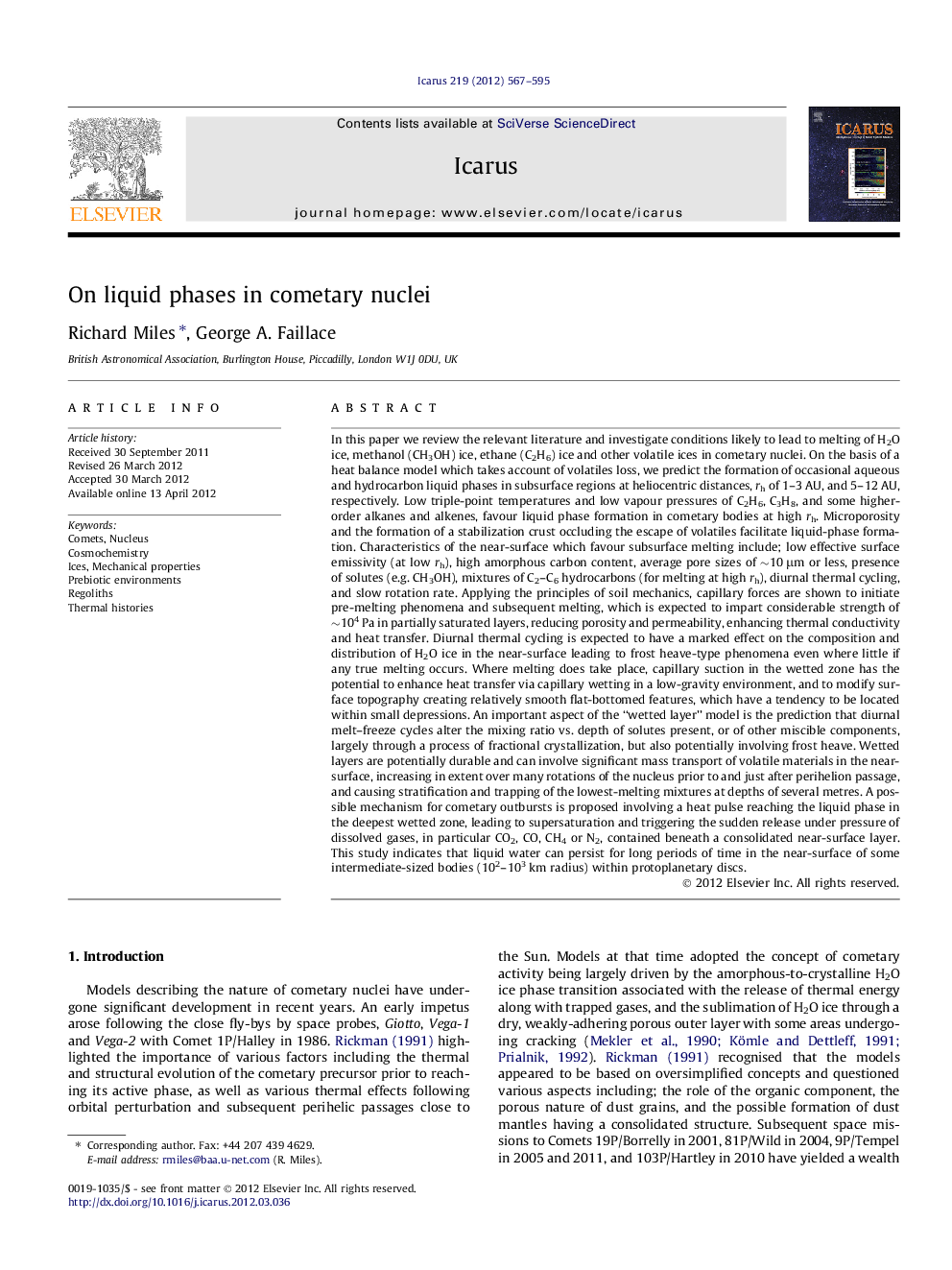| کد مقاله | کد نشریه | سال انتشار | مقاله انگلیسی | نسخه تمام متن |
|---|---|---|---|---|
| 1773590 | 1021140 | 2012 | 29 صفحه PDF | دانلود رایگان |

In this paper we review the relevant literature and investigate conditions likely to lead to melting of H2O ice, methanol (CH3OH) ice, ethane (C2H6) ice and other volatile ices in cometary nuclei. On the basis of a heat balance model which takes account of volatiles loss, we predict the formation of occasional aqueous and hydrocarbon liquid phases in subsurface regions at heliocentric distances, rh of 1–3 AU, and 5–12 AU, respectively. Low triple-point temperatures and low vapour pressures of C2H6, C3H8, and some higher-order alkanes and alkenes, favour liquid phase formation in cometary bodies at high rh. Microporosity and the formation of a stabilization crust occluding the escape of volatiles facilitate liquid-phase formation. Characteristics of the near-surface which favour subsurface melting include; low effective surface emissivity (at low rh), high amorphous carbon content, average pore sizes of ∼10 μm or less, presence of solutes (e.g. CH3OH), mixtures of C2–C6 hydrocarbons (for melting at high rh), diurnal thermal cycling, and slow rotation rate. Applying the principles of soil mechanics, capillary forces are shown to initiate pre-melting phenomena and subsequent melting, which is expected to impart considerable strength of ∼104 Pa in partially saturated layers, reducing porosity and permeability, enhancing thermal conductivity and heat transfer. Diurnal thermal cycling is expected to have a marked effect on the composition and distribution of H2O ice in the near-surface leading to frost heave-type phenomena even where little if any true melting occurs. Where melting does take place, capillary suction in the wetted zone has the potential to enhance heat transfer via capillary wetting in a low-gravity environment, and to modify surface topography creating relatively smooth flat-bottomed features, which have a tendency to be located within small depressions. An important aspect of the “wetted layer” model is the prediction that diurnal melt–freeze cycles alter the mixing ratio vs. depth of solutes present, or of other miscible components, largely through a process of fractional crystallization, but also potentially involving frost heave. Wetted layers are potentially durable and can involve significant mass transport of volatile materials in the near-surface, increasing in extent over many rotations of the nucleus prior to and just after perihelion passage, and causing stratification and trapping of the lowest-melting mixtures at depths of several metres. A possible mechanism for cometary outbursts is proposed involving a heat pulse reaching the liquid phase in the deepest wetted zone, leading to supersaturation and triggering the sudden release under pressure of dissolved gases, in particular CO2, CO, CH4 or N2, contained beneath a consolidated near-surface layer. This study indicates that liquid water can persist for long periods of time in the near-surface of some intermediate-sized bodies (102–103 km radius) within protoplanetary discs.
► Wetted layer model proposed for cometary nuclei.
► Melting conditions for ices of H2O, methanol and hydrocarbons identified.
► Physical change dependent on microporosity and diurnal thermal cycling.
► Novel mechanism for cometary outbursts proposed.
► Liquid water possible in intermediate-sized bodies within protoplanetary discs.
Journal: Icarus - Volume 219, Issue 2, June 2012, Pages 567–595